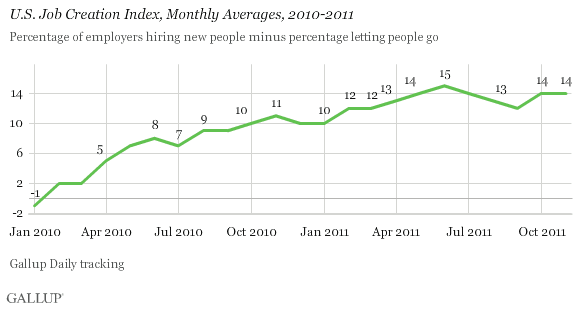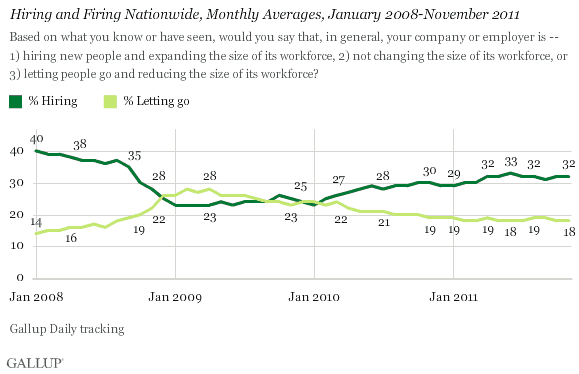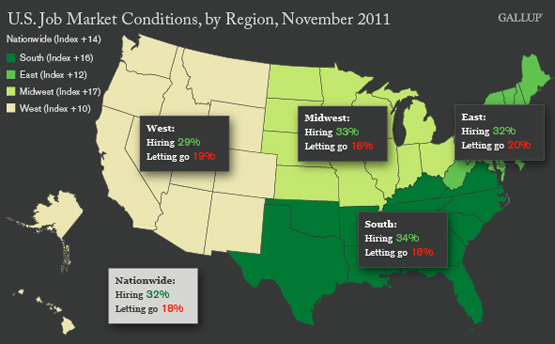PRINCETON, NJ -- Job market conditions in the United States were flat in November, as Gallup's Job Creation Index remained at +14, similar to the range seen since May. This is another indication that Friday's sharp drop to 8.6% in the government's U.S. unemployment rate may be overstated.

Gallup's Job Creation Index generally has been flat since it hit +14 in May. Still, it is up three percentage points from a year ago and remains higher than the monthly readings Gallup found throughout 2009 and 2010.
Hiring Up, While Firing Is Down
The Job Creation Index of +14 is based on 32% of workers nationwide saying their employers are hiring and 18% saying their employers are letting workers go -- the same as in October. Hiring was at 30% and firing at 19% in November 2010.

Job Market Conditions Essentially Flat in All Regions
Job market conditions remain best in the Midwest, with a Job Creation Index of +17; the South is second, at +16. The index is at +12 in the East and +10 in the West. Still, the West has seen the largest year-over-year improvement, with the Index there increasing from +5 in November 2010; improvement is smallest in the East, where the Index was at +11 a year ago.

Implications
The lack of change in Gallup's Job Creation Index is consistent with the relatively flat recent trend in weekly jobless claims, which are running around 400,000 as reported by the government. The index's continued relatively high level for the year is also consistent with expectations of relatively good holiday sales this year.
However, the Job Creation Index's stability does not seem to align with Friday's government report that the U.S. unemployment rate fell to 8.6% on a seasonally adjusted basis and 8.2% without adjustment. Instead of being flat, it would seem that Gallup's November Job Creation Index should have shown substantial improvement and jobless claims a substantial decline as unemployment tumbled. Instead, the lack of change in these trends seems to be another indication of the unusual nature of November's unemployment rate decline.
Digging into the government's unemployment data shows that the size of the U.S. workforce declined by 405,000 in November, while the number of employed Americans increased by 83,000 on an unadjusted basis. As such, the U.S. workforce is no larger than it was a year ago. If the employees who dropped out of the workforce last month still had been looking for work, the unadjusted unemployment rate would have remained essentially flat at 8.5% in November.
Given this context, it appears that the real U.S. jobs situation did not change in November, with hiring and firing activity remaining about the same as in October. Further, it may be that the sharp decline in the U.S. unemployment rate last month was more of a negative than a positive sign for the U.S. economy. The sharp decline in the workforce last month may be more of a reflection of the large number of Americans who have given up looking for work -- as a result of the length and depth of the jobs recession -- than of any improvement in job market conditions.
Gallup.com reports results from these indexes in daily, weekly, and monthly averages and in Gallup.com stories. Complete trend data are always available to view and export in the following charts:
Daily: Employment, Economic Confidence and Job Creation, Consumer Spending
Weekly: Employment, Economic Confidence, Job Creation, Consumer Spending
Read more about Gallup's economic measures.
View our economic release schedule.
Survey Methods
For Gallup Daily tracking, Gallup interviews approximately 1,000 national adults, aged 18 and older, each day. The Gallup Job Creation Index results are based on a random sample of approximately 500 current full- and part-time employees each day.
National results for November are based on Gallup Daily tracking interviews with 16,564 employees conducted Nov. 1-30, 2011. For this sample, one can say with 95% confidence that the maximum margin of sampling error is ±1 percentage point. Regional results for November are based on interviews totaling more than 3,000 in each region. For each total regional sample, the maximum margin of sampling error is ±3 percentage points.
Interviews are conducted with respondents on landline telephones and cellular phones, with interviews conducted in Spanish for respondents who are primarily Spanish-speaking. Each sample includes a minimum quota of 400 cell phone respondents and 600 landline respondents per 1,000 national adults, with additional minimum quotas among landline respondents by region. Landline telephone numbers are chosen at random among listed telephone numbers. Cell phone numbers are selected using random-digit-dial methods. Landline respondents are chosen at random within each household on the basis of which member had the most recent birthday.
Samples are weighted by gender, age, race, Hispanic ethnicity, education, region, adults in the household, and phone status (cell phone only/landline only/both, cell phone mostly, and having an unlisted landline number). Demographic weighting targets are based on the March 2010 Current Population Survey figures for the aged 18 and older non-institutionalized population living in U.S. telephone households. All reported margins of sampling error include the computed design effects for weighting and sample design.
In addition to sampling error, question wording and practical difficulties in conducting surveys can introduce error or bias into the findings of public opinion polls.
For more details on Gallup's polling methodology, visit www.gallup.com.
